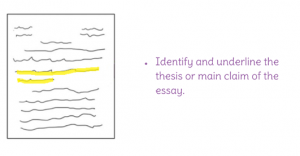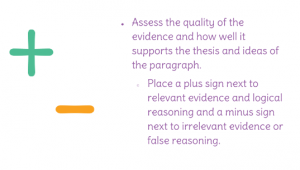Tomorrow, you will have the entire class to write your essay. You can either start with a hand written copy or a Google doc.
Make sure that you use the thesis statement you created today in class.
Remember your heading should look like:
Kim Smith Your Name
Mrs. Scales Teacher’s Name
English 9 – Period 3 Class Information
7 March 2017 Date in MLA format
Introduction
- Your first paragraph should begin with a hook that draws the reader’s attention to your paper.
- You must identify the title and author of the text you are writing about. In this case that means writing The Metamorphosis in italics or underlined if being hand written and stating that it was written by Franz Kafka.
- Your first paragraph should end with your thesis statement.
Body paragraphs
- A topic sentence for each body paragraph. That is like a mini-thesis statement that supports the real thesis statement, and controls the direction of the essay.
- Support for topic sentences that are properly cited with the page # it came from. This would look like (42).
- Transitions to and from the previous and next paragraph.
Conclusion
- Clearly wraps up the paper
- Returns to, but does not simply repeat the thesis
- Tells the reader’s what you want them to take away from the paper
The Rubric being used for this assignment has five parts. You should read the descriptors for each level of all five parts and pay special attention to the differences represented by the bolded world.
UNDERSTANDING (20%)
Outstanding 20 pts
Reading and Understanding of text is outstanding. Writing demonstrates full comprehension of ideas both explicit and inferential indicated by grade-level reading standard. Accurate analysis and reasoning is demonstrated through ample textual evidence.
Good 15 pts
Reading and Understanding of text is strong. Writing demonstrates comprehension of ideas both explicit and inferential indicated by grade-level reading standard. Mostly accurate analysis and reasoning is demonstrated through adequate textual evidence.
Average 10 pts
Reading and Understanding of text is acceptable. Writing demonstrates limited comprehension of ideas both explicit and inferential indicated by grade-level reading standard. Minimally accurate analysis and reasoning is demonstrated through limited textual evidence.
Needs Improvement 5 pts
Reading and Understanding of text is below grade-level expectations. Writing demonstrates weak comprehension of explicit ideas and no comprehension of inferential ideas indicated by grade-level reading standard. Very weak analysis and reasoning is demonstrated through faulty textual evidence.
Unacceptable 0 pts
Shows no comprehension of ideas indicated by grade-level reading standards. Inaccurate or no analysis and reasoning is demonstrated with little or no textual evidence.
IDEAS (20%)
Outstanding 20 pts
Addresses the prompt and introduces a complete thesis with precise claim(s). Body paragraphs have defined topic sentences that all support the thesis.
Good 15 pts
Addresses the prompt and introduces a thesis with claim(s). Body paragraphs have defined topic sentences that support the thesis.
Average 10 pts
Addresses the prompt and introduces a thesis attempt with a an attempt at a claim(s). Body paragraphs support the thesis.
Needs Improvement 5 pts
Does not fully addresses the prompt or introduces a weak thesis. No claim(s) expressed. Body paragraphs do not adequately support the thesis.
Unacceptable 0 pts
No thesis statement.
ORGANIZATION (20%)
Outstanding 20 pts
Development is even and organized to make important connections and distinctions with relevant support. Language creates cohesion and clarifies relationship among ideas. Formal and objective style and tone consistently demonstrates awareness of purpose and audience.
Good 15 pts
Development is organized with some support and cohesion. Language creates cohesion and links ideas. Style and tone demonstrates awareness of purpose and audience.
Average 10 pts
Development and support are minimal. Language links ideas. Style and tone demonstrates limited awareness of purpose and audience.
Needs Improvement 5 pts
Lacks organization, or is undeveloped, and provides little support. Or Language and style develop no awareness of purpose or audience.
Unacceptable 0 pts
Lacks organization, is undeveloped, and does not provide support. Language and style develop no awareness of purpose or audience.
CONVENTIONS (20%)
Outstanding 20 pts
Full command of conventions indicated by grade-level standards. Few minor errors do not interfere with the meaning of the text.
Good 15 pts
Command of conventions indicated by grade-level standards. May have minor errors that occasionally interfere with overall meaning or readability.
Average 10 pts
Some command of conventions indicated by grade-level standards. Several minor errors that interfere with overall meaning or readability.
Limited command of conventions indicated by grade-level standards. Errors often interfere with overall meaning or readability.
No command of conventions indicated by grade-level standards. Frequent and varied errors often interfere with overall meaning or readability.
MLA (20%)
Proper Times New Roman 12 pt double spaced font with indented paragraphing. Four line heading correct. Two or more in-text citations correctly used, and a properly formatted Works Cited page all demonstrate a strong grade-level command of MLA format.
Proper Times New Roman 12 pt double spaced font with indented paragraphing. Four line heading mostly correct. One or more in-text citations correctly used, and a properly formatted Works Cited page all demonstrate an adequate grade-level command of MLA format.
Mostly proper Times New Roman 12 pt double spaced font with indented paragraphing. Four line heading mostly correct. One or more in-text citations correctly used, and a properly formatted Works Cited page all demonstrate an understanding of grade-level MLA format requirements.
Errors in proper Times New Roman 12 pt double spaced font with indented paragraphing. Missing any part of the four line heading, improper or missing in-tex citations and multiple errors on the Works Cited page indicate a weak understanding of grade-level MLA format requirements.
Multiple errors or missing MLA requirements.

